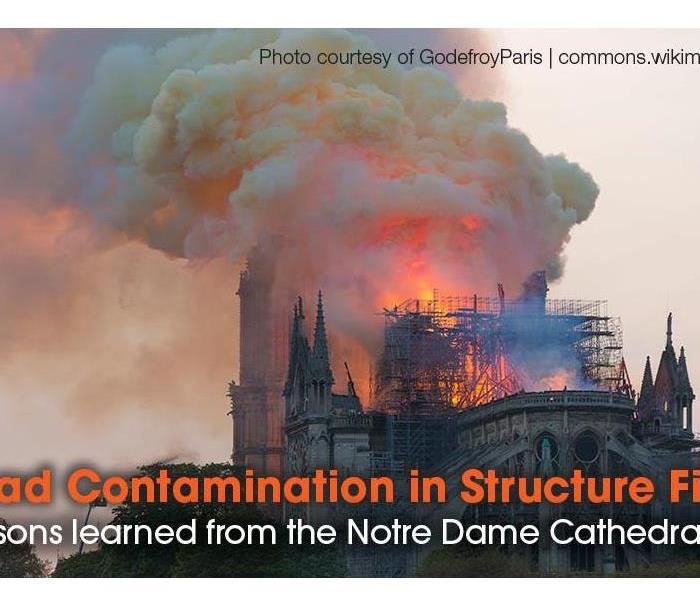Lead Contamination in Structure Fires
11/1/2019 (Permalink)
On April 15, 2019, fire broke out beneath the roof of the Notre-Dame de Paris Cathedral. Over 400 firefighters fought the blaze, which consumed approximately two thirds of the roof structure, including the 300-foot wooden spire.
The roof’s layers and spire, composed of approximately 450 tons of lead, quickly melted as the fire temperatures exceeded 1,400° F. As the smoke’s distinct yellow tinge suggested, the lead vaporized and created a toxic fallout of lead dust that was deposited across Paris.
In July of 2019, reports began to emerge that the levels of lead in areas surrounding the cathedral were 500 to 800 times the official safe level.
An Unexpected Threat - Lead Fumes and Fallout
During a structure fire, lead fumes are produced when lead or lead-containing materials are heated to temperatures above 932° F. At these temperatures, lead vapor is released in the form of highly toxic lead oxide fumes. This vapor then condenses into solid fume particles which are released into the atmosphere.
Lead oxide is highly soluble in body fluids. The particle size of the metal fumes range between 0.1-0.7 microns, which increases the likelihood of inhalation and deposition of the fume directly into the bloodstream. When materials containing lead vaporize, the lead-laden smoke and other byproducts combine to form toxic particulate matter that permeate surfaces in the form of ultra-fine lead dust. Molten lead or lead fumes also contain other toxic byproducts including chromium, cobalt, arsenic, cadmium, antimony, and mercury.
Lead Contamination in New Buildings
Although the sheer volume of lead that vaporized in the Notre Dame fire was unique, fire restoration contractors need to consider the likelihood that lead may be present in any fire damaged structure, especially those built after 1978. Now you may be asking yourself, “did he just say after 1978?” Believe it or not, lead based products are still being used in homes and buildings to this day. It is conceivable that the level of lead contamination resulting from molten lead and lead-laden fumes could pose a greater risk of exposure than the small amount found in lead-based paint or ceramic tile glazing. This could come from a wide range of common household products.
Here are some common materials and household items that may contain lead.
Building Products:
- Lead-based paints
- Ceramic tile glazing
- Porcelain glazing on bathtubs and sinks
- Stained glass windows
- Lead water piping
- Pipe solder
- Roof flashings
- Lead lag shields
- PVC
- Solar cells
- Rubber and plastics (Lead oxide and lead chromate)
Household Items:
- Diving weights
- Fishing weights and lures
- Ammunition
- Batteries
- Tire weights
- Electronics
- Jewelry
- Antiques
- Earthenware, china, porcelain
- Artificial turf
- Artificial Christmas trees
- Drapery weights
- Children’s toys and books printed prior to 1985
Copyright ©2019. All Rights Reserved BNP Media.
Design, CMS, Hosting & Web Development
https://www.randrmagonline.com/articles/88641-lead-contamination-in-structure-fires





 24/7 Emergency Service
24/7 Emergency Service
